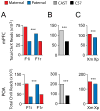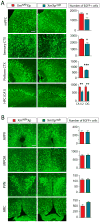Sex-specific parent-of-origin allelic expression in the mouse brain
- PMID: 20616234
- PMCID: PMC2997643
- DOI: 10.1126/science.1190831
Sex-specific parent-of-origin allelic expression in the mouse brain
Abstract
Genomic imprinting results in preferential gene expression from paternally versus maternally inherited chromosomes. We used a genome-wide approach to uncover sex-specific parent-of-origin allelic effects in the adult mouse brain. Our study identified preferential selection of the maternally inherited X chromosome in glutamatergic neurons of the female cortex. Moreover, analysis of the cortex and hypothalamus identified 347 autosomal genes with sex-specific imprinting features. In the hypothalamus, sex-specific imprinted genes were mostly found in females, which suggests parental influence over the hypothalamic function of daughters. We show that interleukin-18, a gene linked to diseases with sex-specific prevalence, is subject to complex, regional, and sex-specific parental effects in the brain. Parent-of-origin effects thus provide new avenues for investigation of sexual dimorphism in brain function and disease.
Figures




Comment in
-
Developmental biology. Which parental gene gets the upper hand?Science. 2010 Aug 6;329(5992):636-7. doi: 10.1126/science.1194692. Science. 2010. PMID: 20689006 No abstract available.
-
A custody battle for the mind: evidence for extensive imprinting in the brain.Neuron. 2010 Aug 12;67(3):359-62. doi: 10.1016/j.neuron.2010.07.026. Neuron. 2010. PMID: 20696374
-
Neurogenomics: Parental influences run deep.Nat Rev Neurosci. 2010 Sep;11(9):609. doi: 10.1038/nrn2899. Nat Rev Neurosci. 2010. PMID: 20803787 No abstract available.
References
-
- Reik W, Walter J. Nat Rev Genet. 2001;2:21. - PubMed
-
- BJB, BKJ, GN, HE, HJP, YE . Sex Differences in the Brain: From Genes to Behavior. Oxford University Press, Inc; New York, New York: 2008.
-
- Bartolomei MS, Tilghman SM. Annu Rev Genet. 1997;31:493. - PubMed
-
- Payer B, Lee JT. Annu Rev Genet. 2008;42:733. - PubMed
Publication types
MeSH terms
Substances
Associated data
- Actions
Grants and funding
LinkOut - more resources
Full Text Sources
Other Literature Sources
Molecular Biology Databases

